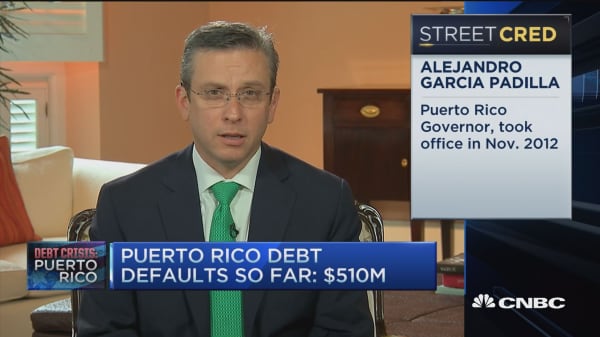Congress may finally be coming to Puerto Rico's rescue after years of fiscal chaos. It may be too late for the island's economy, however.
A House panel is working on a draft of a rescue plan, but political hurdles remain, and worse, it's still not clear whether the measure can reverse the U.S. territory's prolonged downward spiral.
The House Committee on Natural Resources was set to take up a series of measures, including a financial oversight board, to help Puerto Rico dig out from under a crushing debt burden that has piled up as the local economy has slowly collapsed.
"What we are seeing in Puerto Rico is if you push it off, the situation gets worse, the debt gets worse, the humanitarian crisis gets worse," the committee's chairman, Utah Republican Rob Bishop, told Reuters. "If you don't want a bailout and you put it off long enough, you probably will be forced into a position of being in a bailout, and I'm not going to vote for that."
On Monday, Treasury Secretary Jack Lew toured a San Juan elementary school that's coping with limited electricity and a hospital no longer able to offer some basic services to infants.
"It can only get worse," Lew told reporters as he toured Eleanor Roosevelt Elementary School in San Juan with Gov. Alejandro Garcia Padilla. "What I have gotten to see first-hand is, there is a growing crisis in Puerto Rico."
That crisis deepened May 1, when Puerto Rico's Government Development Bank defaulted on some $370 million in debt payments, spurring Congress to act in hopes of heading off a wave of lawsuits from creditors.
The GDB now faces a July 1 deadline to pay another $2 billion owed investors on some $70 billion in overall borrowing, a debt that government officials and independent observers say is unsustainable.
The bill in Congress would set up an independent oversight board tasked with restructuring Puerto Rico's debt and working with local officials to come up with an economic reform plan. But the bill includes no direct aid, at the insistence of sponsors who oppose a "bailout."
House Speaker Paul Ryan, R- Wisc., who also opposes direct aid, has said that such a measure may be needed if Congress doesn't act and Puerto Rico's economy collapses.
Debt relief would give Puerto Rico's government some breathing room. But by itself, it would do little to reverse an ongoing economic decline that has been underway for a decade.
A report last year by a trio of former IMF economists found that Puerto Rico suffers from structural economic problems that are not going away without major reforms.
Since the Great Recession ended, employment levels have recovered on most of the U.S. mainland, and companies have added to payrolls.
But Puerto Rico's job base continues to shrink, taking its economy with it. Since the recession ended, overall payrolls have contracted by 9 percent, as a lack of job prospects has sent many Puerto Ricans fleeing to the mainland, where the job market is much stronger. During the same period, overall U.S. employment rose by nearly 8 percent.
The out-migration started before the recession that began in 2007. From a peak of 3.8 million in 2004, Puerto Rico's population fell to about 3.5 million last year, according to census estimates, marking a decline of 8 percent.
Puerto Rico's economic slide began before the Great Recession, in part due to the loss of a tax credit for companies that set up manufacturing on the island. Those credits expired in 2006.
Since then, the drop in employment continues to drive the out-migration, as unemployment remains stubbornly high at 11.8 percent — more than twice the average U.S. rate of 5 percent, as of April.
The departure of younger workers has left the territory with an older, poorer population, further straining the government's social services. It's also left the local economy with fewer active workers; as of June, just over 40 percent of Puerto Rico's population was officially counted as part of the labor force. (The U.S. average in April was 62 percent.)
Some of those missing from the workforce are part of an "informal" economy that employs "a large segment of the population" and allows "workers and firms to avoid many of the taxes and other costs associated with formal employment," according a 2014 report by the New York Federal Reserve.
Because that work is conducted off the books, it's difficult to know just how much tax is lost, but the New York Fed report put the informal economy at roughly a quarter of Puerto Rico's gross domestic product.
With Puerto Rico's job base shrinking, and sales and income taxes lost to an underground economy, the government has financed its budget shortfalls with borrowed money, adding to a crushing debt burden.
The government's heavy debt load has brought a series of credit downgrades, raising its borrowing costs further. Efforts to narrow its budget deficit brought higher taxes and layoffs of government workers, further dampening the prospects for economic growth.
Cuts in basic services have accelerated the emigration of people and businesses.
The government has proposed several restructurings in recent years. But continued job losses likely will make it harder to reverse the downward spiral and get the territory's economy back on track.
Nearly two years ago, New York Fed officials warned that the day of reckoning loomed.
"The island appears to face two alternatives," New York Fed officials wrote in 2014. "Either manage its own economic adjustment and put the commonwealth on a secure fiscal basis, or wait for out-migration and the discipline of the market to force an even more painful adjustment, particularly for those unable or unwilling to leave the Island."





